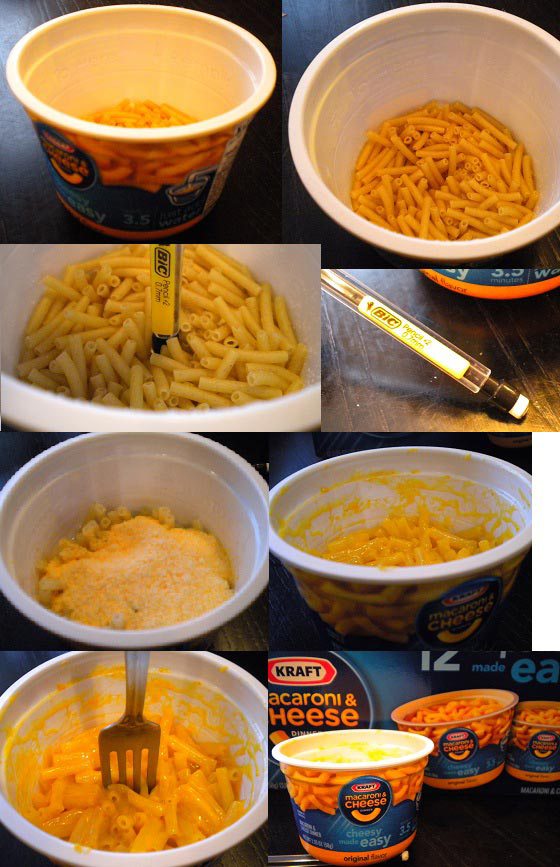Packaging Vs. Reality: Kraft Macaroni And Cheese Cups
Jay is smart, and knows that packaged food never quite turns out the way it looks on the box. It’s not physically possible. But he was surprised, when cooking a pre-packaged cup of Kraft macaroni and cheese from Costco, that the quantity of food-like substance in the cup didn’t really measure up to what was shown on the box. Is he overreacting, or is this really an unrealistic portrayal of the food product within?
We picked up this box of Kraft “cheesy and easy” Macaroni and Cheese cups at Costco. The box art shows a cup that is nearly filled to the brim with cheesy goodness. The art is believable, there is nothing on the box to suggest that this portion is unrealistic. There is no explicit fine print stating that the art is just art, there is no implicit cue that the cups are impossible to fill up to that level. The consumer should have no reason to expect the product would be otherwise.
I cooked it and realized the actual product is roughly 50% of what’s on the box. Attached are the pictures before and after cooking, using a BIC pencil end (where the entire black eraser end is only .50 inch) to show the height level of the uncooked pasta. Just for giggles after cooking I positioned the cup and angled it so it resembles what’s on the box, only it looks nothing like what’s on the box. Egads! Maybe that’s why they neglected to show consumers the truth? Who would buy this unless Kraft could sucker them with an absurdly inflated product?
There was some message on the cup wrapper to the effect that the macaroni pieces on the rim of the wrapper are blown up but that’s irrelevant unless they’re saying you have to buy it first, open it to read the message only visible clearly on the cups, then make the mental leap that inflated pieces of pasta on one piece of art implies that they inflated the pasta on another piece of art. Maybe they even want you to know how much a piece of uncooked macaroni weighs and do the math at Costco to know there can’t possibly be that much macaroni in the box. Yeah, sure or maybe they can just tell the truth which “might” be easier.
To rule out cooking conditions I tested different cooking times believing there was a possible microwave power factor influencing this. The results were the same and with that amount of pasta, blaming it on cooking conditions is not plausible. Then I thought maybe they couldn’t put that much in there because it would be impossible to stir but the roughly half inch space they show on the box should be enough. That excuse doesn’t justify lying to consumers anyway, if they did this to make it easier to stir they should show the true size on the box. Nothing justifies adding this much plastic waste and lying about it. Adding that much plastic you don’t need per cup compared to the actual food in there and making these cups so small is just so wasteful.
Maybe Kraft made that much in one cup using a specially tuned microwave but I doubt it based on my tests. The average consumer probably isn’t going to achieve those conditions anyway, losing half of what’s shown on the box due to conditions would be absurd. This is fraud at worst, disingenuous at best. Being a monolithic company they probably have some sly legalese to hide behind. Look, I’m not the kind of person to argue if the food varies by some small percentage but this is roughly 50% and that’s a LOT to lose.
If my memory of Easy Mac physics is correct, it would be impossible for the cooked pasta to reach that level without boiling over while microwaving, so the cup can’t be that full. Which might still make it an unfair marketing image, but for a good reason.
Want more consumer news? Visit our parent organization, Consumer Reports, for the latest on scams, recalls, and other consumer issues.


